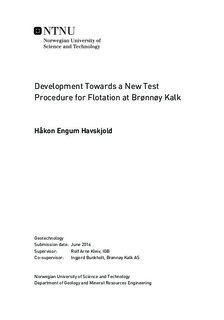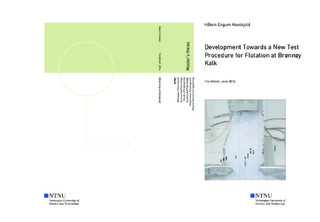| dc.description.abstract | Brønnøy Kalk AS is a mining company established in 1997 and is localized in Brønnøy, Norway. Approximately 2 million tonnes of ground calcium carbonate (GCC) raw material is mined annually. No processing of the marble is performed by Brønnøy Kalk; the raw material is sent to an off-site processing plant where the impurities are removed using reverse froth flotation. However, the quality of the blocks in the open pit is analysed in a laboratory procedure at Brønnøy Kalk. In short, the blocks are analysed for expected brightness, to enable the correct mixing of different grades. As part of the quality inspection, the raw material is subjected to bench scale reverse froth flotation. The processing plant successfully switched the collector used in the flotation process at the plant, prompting the same change of the collector used in the bench scale flotation procedure at Brønnøy Kalk. However, initial testing with the new collector proved difficult, as the results achieved with the standard flotation procedure used with the new collector resulted in a high deviation from the results achieved when using the original collector, as well as low reproducibility in replicates when using the new collector.
The first part of the study addresses the use of an off-site laboratory for performing flotation experiments, as part of reducing the need to travel to Brønnøy Kalk to perform experiments. The second part of the study addresses the assumed reasons for the difficulties in using the new collector in the bench scale flotation procedure at Brønnøy Kalk. The main experiments were on the particle size distribution (PSD) of the flotation feed, as it was assumed that the lifting capacity of the new collector was less than for the original collector. The reduction of the PSD was assumed to increase the reproducibility of the flotation procedure.
The main findings of the study includes the difficulties faced when using off-site laboratories, and that the reduced PSD of the flotation feed improved the flotation process when using the new collector. Using the laboratories at NTNU proved problematic, as many aspects of the flotation procedure were different from the procedure used at Brønnøy Kalk. The flotation cell and the flotation operators are emphasized. The study on the PSD revealed increased brightness in the final concentrate when reducing the PSD of the flotation feed. The experiments also showed reduced variance in the replicate trials when reducing the PSD of the flotation feed. The thesis includes a suggestion for a new flotation procedure for flotation using amine B. | en |

